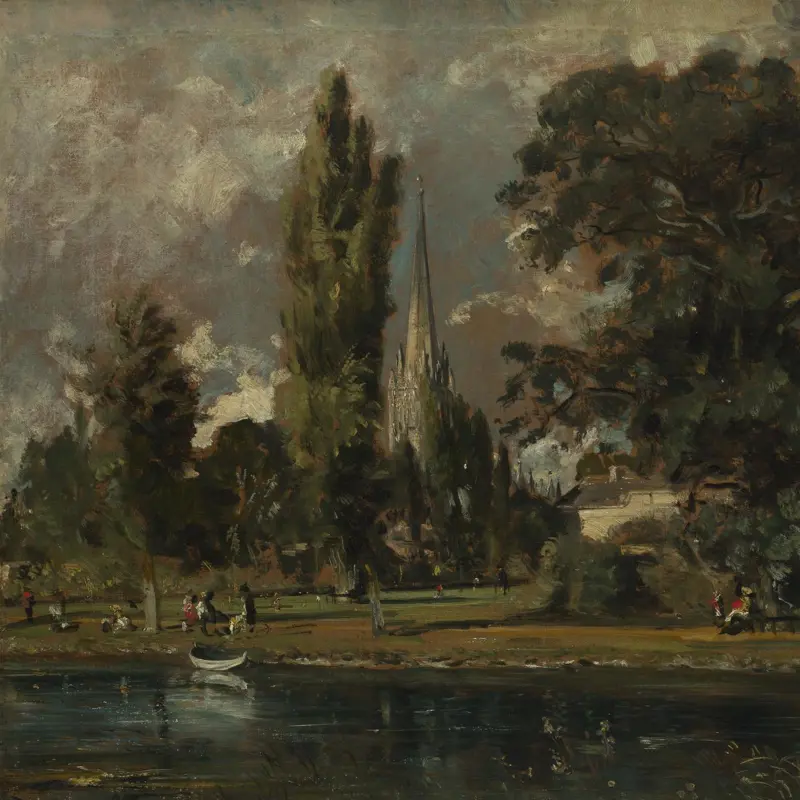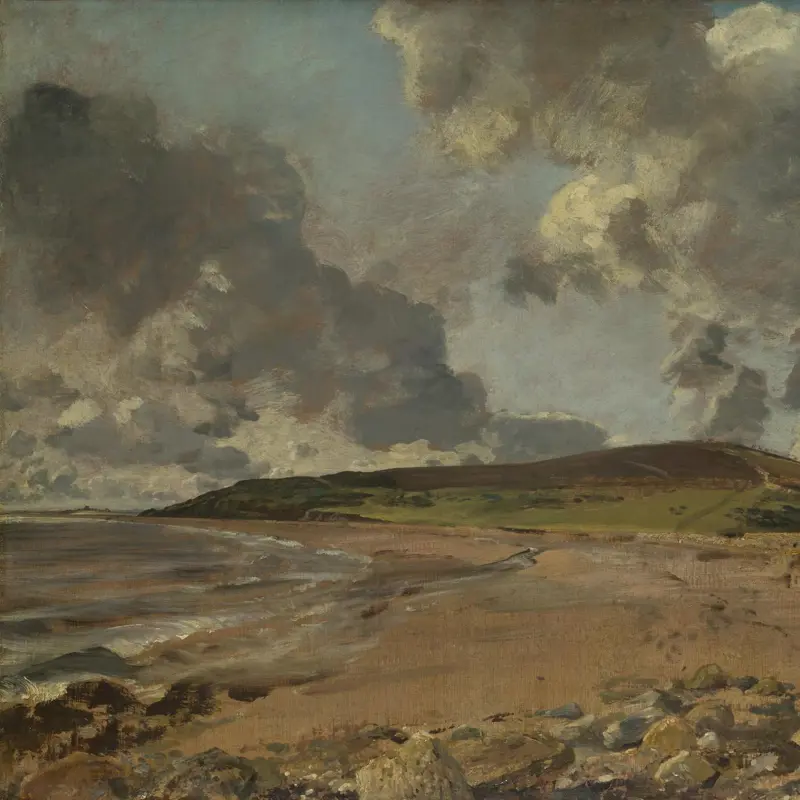John Constable, 'The Cornfield', 1826
About the work
Overview
A boy has paused from the thirsty work of herding sheep at noon to lie flat on the bank of a pool and drink its cool water. This vision of a Suffolk lane in high summer was painted in January to March 1826 in Constable’s studio in London. The lane winding into the cornfield is based on Fen Lane, along which Constable had often walked as a boy from his own village of East Bergholt to Dedham, where he attended school. The lane still exists but the countryside shown beyond it was largely invented.
Constable exhibited the painting at the Royal Academy in 1826. Despite receiving critical praise, it failed to sell, either at the Royal Academy or at any of the four other exhibitions to which Constable sent it. A committee of friends and admirers finally bought The Cornfield and presented it to the National Gallery in 1837 as a tribute to Constable after his death.
Audio description
Listen to an audio description of Constable's iconic painting, 'The Cornfield'
Transcript
John Constable painted 'The Cornfield' for London’s Royal Academy exhibition which opened to the public in May 1826. The oil painting is almost square, measuring 143 cm high by 122 cm wide, or 56 by 48 inches. It’s set within a gilt frame.
Its perspective draws us in, as if we are out for a stroll in the countryside, along a lane lined with mature trees. The sand-brown path slopes down towards a right-hand bend, where straight ahead of us, an open farmgate leads to a sloping field of wheat – the cornfield of the picture’s title – which is lit by a break in the clouds. At the far edge of the field, a wide river flows through a water meadow. Beyond this, a church and red-roofed houses nestle among trees. Further still, and less than half way up the painting, rolling hills lead to a vanishing point where land meets the sky.
On the lane ahead of us is a flock of a dozen or so sheep, some with their rumps in sunlight as they amble towards the bend in the lane. A black and white sheepdog, possibly a Border Collie, which should be keeping them in order, has stopped in its tracks, distracted by the sight or sound of a bird, most likely a wood pigeon, fluttering high up in the trees on the left. In the bottom left corner, a boy with sun-streaked blond hair lies face down on a grassy verge drinking from a pool. Dressed in a white shirt, red sleeveless waistcoat, brown knee breeches, rumpled grey socks and shoes, his felt hat lays on the grass beside him.
In the middle of the painting’s composition, where the path bends to the right, a farmgate hangs open against a hedge, its top hinge broken. A wooden plough with metal blade sits on the verge to the right of the gateway, a reminder that the wheat must be harvested first before the land can be tilled.
Standing just inside the field, to the right of the gateway, a man in a white shirt, with a bright red neckerchief and floppy hat is visible from the waist up. Although his features are indistinct, he appears to be looking toward us, or perhaps at the approaching sheep. At the far end of the field are the tiny shapes of two men, also dressed in white shirts and dark hats, the angle of their forms suggesting that they are bent over harvesting the wheat.
Returning to the foreground, a little further along the grassy verge where the boy lies drinking, a donkey crops a hedgerow, while its foal looks towards the boy. On the opposite bank of the pool, to the left of this scene, stands a dying oak, its bark a similar greyish-white to the foal, its yellowing leaves caught in sunlight.
As the embankment recedes into the distance, taking us towards the open gate, is a line of three tall, impressive elms. The trunk of the tree closest to us is dark brown and ivy covered. Standing closer to the edge of the cornfield, the other two trunks are a lighter brown, bright in the sun. The three trees fill the frame almost to the top, meeting a steel blue cloud-laden sky in the top left corner.
At the foot of these trees, in sharply described detail, are wild grass and indigenous plants. Butterbur is in the wet patches in the foreground. Its name is attributed to the traditional use of its large leaves to wrap butter in warm weather. Beneath the dying oak thrive wild rose and cow parsley with clusters of flowers. Poppies stand in bright contrast against the subtle shades of vegetation as delicate flecks of red – the same red as the boy's waistcoat, the man’s neckerchief and the red-roofed houses in the distance.
In the wood to the right of the lane, beneath which the flock of sheep are in semi-shade on the lane, a young birch tree with a silvery trunk and pale delicate leaves, grows in front of several oaks. Their upper branches appear to bend to the presence of the cumulus clouds above. The height of these oak trees is almost half that of the elms on the left.
A title Constable used for the painting, Landscape: Noon suggests that he wished to portray this pastoral scene at midday. The clouds are brightest at the top right of the painting giving the impression that the sun is high in the sky. Pale white above and a metallic grey brushstroke underneath accentuate the clouds' volume and movement. We are reminded of the changeability of the English weather and being caught in an unexpected downpour on our walk. The cumulus mass scatters light over the treetops and on their outer branches the stippled leaves have the appearance of shimmering in a breeze.
Painted in his studio in London, Constable based the lane on childhood memories of Fen Lane in Suffolk, which led from his birthplace, East Bergholt, across the meandering River Stour, to the neighbouring village of Dedham, where he had attended school. According to the artist's eldest son, Charles, he added the distant village, with its square church tower and poppy red roofs, for the sake of a vista. Artistic license was also used in the wildlife he chose to depict: the wild roses and cow parsley beneath the dying oak both flower in early summer and are therefore out of season with the near ripeness of the cornfield.
Hoping that his art might inspire others to want to appreciate the natural beauty of their surroundings, Constable strived to show the textures he saw in nature, using a palette knife and brushes to create expressive surfaces. While this approach was criticised among his English contemporaries for appearing ‘unfinished’, it was praised by French art collectors.
Constable prepared the painting for the Royal Academy exhibition of 1826, and then sent it to the Paris Salon in 1827. It failed to sell and remained in his studio. Shortly after his death in 1837 a committee of friends and admirers raised the money to buy the painting and named it The Cornfield before presenting it to the National Gallery. It was the first work by Constable to enter the national collection.
Key facts
Details
- Full title
- The Cornfield
- Artist
- John Constable
- Artist dates
- 1776 - 1837
- Date made
- 1826
- Medium and support
- Oil on canvas
- Dimensions
- 143 × 122 cm
- Inscription summary
- Signed; Dated
- Acquisition credit
- Presented by subscribers, including Wordsworth, Faraday and Sir William Beechey, 1837
- Inventory number
- NG130
- Location
- Room 40
- Collection
- Main Collection
- Acquisition funders
- Frame
- 18th-century French Frame
Provenance
Additional information
Text extracted from the ‘Provenance’ section of the catalogue entry in Judy Egerton, ‘National Gallery Catalogues: The British Paintings’, London 2000; for further information, see the full catalogue entry.
Exhibition history
-
2012Seduced by Art: Photography Past and PresentThe National Gallery (London)31 October 2012 - 20 January 2013
-
2013Constable' Cornfield: 'A Specimen of Geniune English Scenery?'Tate Britain25 March 2013 - 29 September 2013
-
2014John Constable: The Making of a MasterVictoria and Albert Museum20 September 2014 - 11 January 2015
-
2021Late ConstableRoyal Academy of Arts30 October 2021 - 13 February 2022
-
2023Constable VisitsNewport and Carisbrooke Community Council5 June 2023 - 11 June 2023Things Made Public12 June 2023 - 18 June 2023South Shields Museum and Art Gallery19 June 2023 - 25 June 2023Dudley Council26 June 2023 - 2 July 2023This is Croydon3 July 2023 - 9 July 2023
-
2024Discover Constable and The Hay WainThe National Gallery (London)17 October 2024 - 2 February 2025
Bibliography
-
1827British Institution, A Catalogue of the Works of British Artists Placed in the Gallery of the British Institution, Pall-Mall, for Exhibition and Sale, London 1827
-
1946Davies, Martin, National Gallery Catalogues: British School, London 1946
-
1946M. Davies, Paintings and Drawings on the Backs of National Gallery Pictures, London 1946
-
1959Davies, Martin, National Gallery Catalogues: British School, 2nd edn (revised), London 1959
-
1965G. Reynolds, Constable: The Natural Painter, London 1965
-
1976A. Smart and A. Brooks, Constable and His Country, London 1976
-
1979J. Gage (ed.), Zwei Jahrhunderte englische Malerei: Britische Kunst und Europa 1680 bis 1880 (exh. cat., Ausstellungsleitung Haus der Kunst München, 21 November 1979 - 27 January 1980), München 1979
-
1983M. Rosenthal, Constable: The Painter and His Landscape, New Haven 1983
-
1991L. Parris and I. Fleming-Williams, Constable, (exh. cat. Tate Gallery, 13 June - 15 September 1991), London 1991
-
1998J. Egerton, The British School, London 1998
-
2000Egerton, Judy, National Gallery Catalogues: The British Paintings, revised edn, London 2000
-
2001
C. Baker and T. Henry, The National Gallery: Complete Illustrated Catalogue, London 2001
Frame
This French eighteenth-century Louis XV style frame is carved from oak and is water-gilded. A French acanthus-leaf motif decorates the back edge, and the highpoint features elegant sweeping outlines with bundled reeding. The corner and centre cartouches are adorned with pierced shell motifs, on either side of which there is the characteristic ‘queue de cochon’ (curled-leaf) and ‘rinceau’ (a branch with foliage). There is no sanded flat (this has been cut away). There is a French acanthus-leaf motif at the sight edge. The frame has areas of punch-tooling, and the engraved lines made by the ‘répareur’ are still visible. When the frame was paired with this painting in 1985, it underwent a meticulous restoration process including new gilding.
About this record
If you know more about this work or have spotted an error, please contact us. Please note that exhibition histories are listed from 2009 onwards. Bibliographies may not be complete; more comprehensive information is available in the National Gallery Library.








